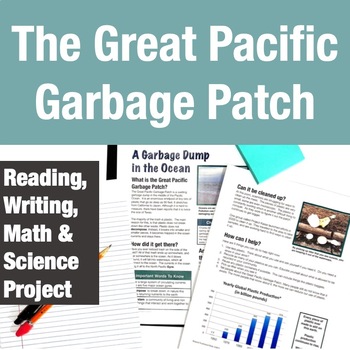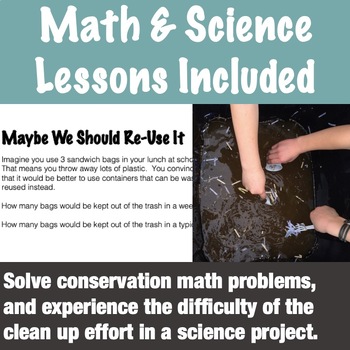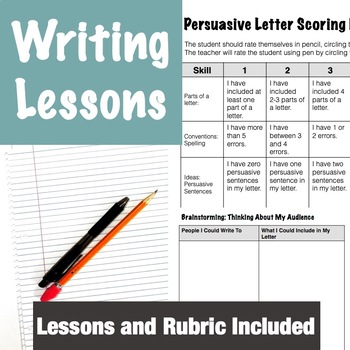Earth Day Activities for Meaningful Learning - Great Pacific Garbage Patch
- PDF
What educators are saying
Description
Looking for a great way to incorporate environmental issues and earth day ideas into your lesson plans? Go beyond a nature walk, coloring sheets and school grounds cleanup with these impactful classroom activities.
The Great Pacific Garbage Patch is an earth day activity that focuses in on the devastating impact of plastic bags, trash pollution, single use plastic, and plastic bottles in our waterways and oceans. This earth day lesson plan is cross curricular, with a focus on reading, writing, math and science experiments. Young people will be inspired to tell their family members about the need to take care of the earth as plastic water bottles are single-use plastics that are truly impacting the way that future generations will live.
What grade level is this appropriate for?
The grade level this is most appropriate for would be upper elementary. In these lessons you will find fun activities and great ideas for meaningful earth day activities. Your students will come away from this as one of their favorite earth day activities, with a desire to make the world a better place. I have found that exploring this issue led to deeper discussion about the history of earth day and other issues that impact our earth like: water conservation, global warming, climate change, recyclable materials, environmental awareness, nature conservancy and the amount of waste we use on a daily basis. This project is a great starting point for young students.
What subjects are covered during this unit of study?
Explore environmental issues on Earth Day by diving deeper with your students in an impactful way. Spend the day learning about this issue in your reading, writing, math and science workshops. Very low prep and easy to implement, a project that your students are sure to remember from Earth Day for years to come.
The Great Pacific Garbage Patch is an environmental problem in the Pacific Ocean. Discovered in 1997, it is still a largely unknown problem to the general public. In this inquiry project students read and learn about the Great Pacific Garbage Patch using informational text (provided), write persuasive letters, and solve conservation math problems. It ends with a water pollution science inquiry experiment. It is perfect for Earth Day, but it can also be done any time of year if studying this issue.
A Reading Focus:
This is a mini informational text reading unit that focuses on the reading strategies of questioning, predicting, activating prior knowledge, and synthesizing. The purpose is for students to think using informational text features (headings, diagrams, graphs, text boxes, etc.). There is a two page informational text about the Great Pacific Garbage Patch included in this resource.
A Writing Focus:
This is a mini opinion/persuasive letter writing unit. The purpose is for students to think about who they could write to, and to communicate what they’ve learned about the Great Pacific Garbage Patch. There is a graphic organizer, weak and strong sample letters, and a list of mini lessons to help you with this mini unit. The rubric attached focuses on three skills for the final letter.
A Math Focus:
There are 4 word problems to help students think about what they can do to conserve and discourage pollution. These problems are tiered and become more difficult, with the last problem being the most challenging.
A Science Focus:
The project ends with a water pollution experiment that is inquiry based. Students try to clean a basin of water with "pollutants" in it, using clean up utensils that you provide. The utensils are marked with different costs, forcing them to think about cost effective clean up. They extend their thinking by connecting it to how difficult the ocean is to clean up.
Included in this resource:
1. Unit introduction and detailed descriptions/lessons
2. Three learning targets for your Readers Workshop
3. Three-six learning targets for your Writers Workshop
4. Four deep math problems, ranging in difficulty to help you differentiate. (Includes two open ended problems.)
5. Reading is Thinking graphic organizer
6. A Garbage Dump in the Ocean: A two page informational text with titles, headings, text boxes, photos, captions, graphs and a mini glossary.
7. Two letters: a weak and strong sample letter
8. Brainstorming: Thinking About my Audience graphic organizer
9. Answer key to math problems.
10. Marzano Scale for Level of Understanding
11. Writing rubric to score paper, for both student and teacher.
12. Water clean up experiment instructions and recording sheet.
Whether this is your first earth day celebration, or you have done this for many years, you'll find that teaching students about environmental protection is a great time for all and I hope you'll make learning about this cause an annual event. Let's celebrate Earth Day in a meaningful way with this project!





